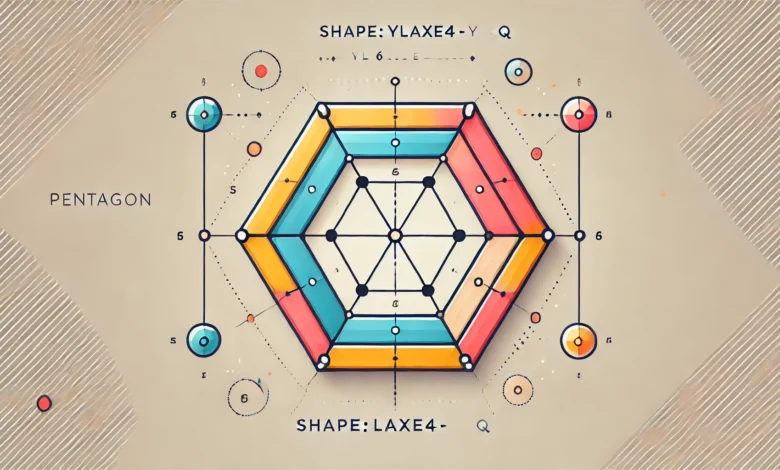Exploring the Shape:yl6axe4-ozq= pentagon – A Comprehensive Guide

When it comes to geometric shapes, the Shape:yl6axe4-ozq= pentagon is one that stands out due to its unique properties and its presence in both everyday life and advanced mathematics. Whether you encounter it in architecture, art, or nature, the pentagon is a fascinating and important shape to understand. In this article, we’ll dive deep into what a pentagon is, its key characteristics, how to calculate its area and perimeter, and its various applications in the world around us.
What is a Shape:yl6axe4-ozq= pentagon?

A Shape:yl6axe4-ozq= pentagon is a polygon with five straight sides and five angles. The word “pentagon” comes from the Greek words “pente,” meaning five, and “gonia,” meaning angle. It is classified as a simple polygon, meaning its sides do not cross each other.
Interestingly, the shape: yl6axe4-ozq= pentagon isn’t just a theoretical concept found in textbooks; it can be seen in many aspects of the world, from the design of famous buildings to the structure of natural elements.
Key Characteristics of a Pentagon
- Five Sides: By definition, a pentagon has five straight edges.
- Five Angles: The sum of the interior angles of a pentagon is always 540 degrees.
- Regular Pentagon: A regular pentagon has equal-length sides and equal interior angles (108 degrees each).
- Irregular Pentagon: An irregular pentagon has sides and angles of different lengths and measures.
Types of Pentagons
The shape: yl6axe4-ozq= pentagon can be categorized into two main types: regular pentagons and irregular pentagons.
Regular Pentagon
A regular pentagon has:
- Equal sides: All five sides are of the same length.
- Equal angles: All interior angles measure 108°.
- Symmetry: A regular pentagon has five lines of symmetry.
Irregular Pentagon
An irregular pentagon:
- Has sides of varying lengths.
- Has interior angles of different measures.
- Does not have symmetry (unless in very specific cases).
The Geometry Behind the Shape: Yl6axe4-Ozq= Pentagon
Understanding the geometry of the shape: yl6axe4-ozq= pentagon involves basic principles of polygons. Here are a few crucial facts about its structure:
- Interior Angles: The sum of the interior angles of any polygon can be calculated using the formula:
- (n−2)×180°(n-2) \times 180°(n−2)×180°
- For a pentagon, where n=5n = 5n=5, the sum of the interior angles is (5−2)×180°=540°(5-2) \times 180° = 540°(5−2)×180°=540°. This means the sum of all five angles in a pentagon will always be 540°.
- Exterior Angles: The sum of the exterior angles of any polygon is always 360°. Since a pentagon has five sides, each exterior angle measures 360°÷5=72°360° ÷ 5 = 72°360°÷5=72°.
How to Calculate the Perimeter and Area of a Pentagon
Perimeter of a Regular Pentagon
To find the perimeter of a regular pentagon, you simply multiply the length of one side by five (since there are five equal sides):
Perimeter=5×side length\text{Perimeter} = 5 \times \text{side length}Perimeter=5×side length
For example, if one side of a regular pentagon measures 6 cm, the perimeter is:
Perimeter=5×6=30 cm\text{Perimeter} = 5 \times 6 = 30 \text{ cm}Perimeter=5×6=30 cm
Area of a Regular Pentagon
The area of a regular pentagon can be calculated using the following formula:
Area=14×5(5+25)×side length2\text{Area} = \frac{1}{4} \times \sqrt{5(5 + 2\sqrt{5})} \times \text{side length}^2Area=41×5(5+25)×side length2
Alternatively, if you know the apothem (the perpendicular distance from the center to the midpoint of a side), the area can also be calculated using:
Area=12×Perimeter×Apothem\text{Area} = \frac{1}{2} \times \text{Perimeter} \times \text{Apothem}Area=21×Perimeter×Apothem
Let’s say the side length of the pentagon is 6 cm and the apothem is 4 cm:
Area=12×30×4=60 cm2\text{Area} = \frac{1}{2} \times 30 \times 4 = 60 \text{ cm}^2Area=21×30×4=60 cm2
Real-World Applications of the Shape: Yl6axe4-Ozq= Pentagon
The shape: yl6axe4-ozq= pentagon can be seen in many aspects of life. Below are some notable uses of the pentagon shape in the real world:
Architecture and Design
- Famous Buildings: The Pentagon, the headquarters of the United States Department of Defense, is an iconic example of a building designed in the shape of a pentagon. Its unique five-sided structure has made it one of the most recognizable buildings globally.
- Tile Patterns: Many tiling designs use pentagons as part of intricate floor patterns. A regular pentagon can be used to form tessellations when arranged correctly.
Nature and Art
- Flowers and Stars: Many flowers, such as the popular star-shaped morning glory, have petals that form a pentagon-like structure. Similarly, the star shape, often used in art and decoration, is closely related to the geometry of the pentagon.
- Geometric Art: The pentagon shape is commonly used in geometric art, from ancient mosaics to modern designs, due to its symmetry and aesthetic appeal.
Engineering and Manufacturing
- Engineering Designs: The pentagon shape is often utilized in engineering to create strong, symmetrical structures. It’s frequently seen in the design of gears, wheels, and certain types of nuts.
- Packaging: Some packaging designs incorporate pentagonal shapes to create unique, sturdy containers or packaging solutions.
Fun Facts About the Pentagon Shape
- Symmetry: Regular pentagons have five lines of symmetry. This means if you fold the shape along these lines, each half will match exactly.
- Golden Ratio: The geometry of the regular pentagon is connected to the golden ratio. The ratio of the length of a diagonal to a side is approximately 1.618, which is the same as the golden ratio found in many natural and artistic forms.
- Pythagoras and the Pentagon: Ancient mathematicians like Pythagoras were fascinated by the pentagon’s geometry and its connection to the golden ratio, which they believed had divine significance.
Comparing the Pentagon to Other Polygons
While the shape: yl6axe4-ozq= pentagon stands out with its five sides, there are several other polygons that have different numbers of sides. Let’s compare a few of them:
PolygonNumber of SidesSum of Interior AnglesInterior Angle (Regular)
Triangle 3 180° 60°
Square 4 360° 90°
Pentagon 5 540° 108°
Hexagon 6 720° 120°
Heptagon 7 900° 128.57°
As shown in the table, the pentagon is distinct in its angle measures and its position among polygons with increasing sides.
Conclusion: The Shape: Yl6axe4-Ozq= Pentagon in Our World
The shape: yl6axe4-ozq= pentagon is much more than just a geometric concept. It is a part of everyday life, appearing in architecture, art, nature, and even engineering. Understanding its properties, such as its angles, symmetry, and applications, can enhance our appreciation for the world around us. Whether you are studying math, creating art, or simply observing the world, the pentagon’s unique shape is all around you.
In summary, the shape: yl6axe4-ozq= pentagon is a fascinating and versatile geometric figure, deeply connected to both practical applications and natural beauty. With its historical significance and continued use in various fields, it remains a key figure in the study of shapes and structures. So, the next time you spot a pentagon in the world, whether in a building, a star, or even in nature, you’ll know that you’re looking at a shape with rich mathematical and cultural significance.

